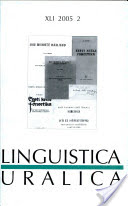On the Temporal Structure of Estonian Secondary-Stressed Feet
On the Temporal Structure of Estonian Secondary-Stressed Feet
Author(s): Karl Pajusalu, Tiit-Rein Viitso, Toomas Help, Pärtel Lippus, Ellen Niit, Pire TerasSubject(s): Language and Literature Studies
Published by: Teaduste Akadeemia Kirjastus
Keywords: Estonian; prosody; quantity; foot; secondary stress
Summary/Abstract: The article focuses on Estonian words of two and more feet, comparing the temporal structures of the feet in words of four to six syllables that consist of short primary- and secondary-stressed syllables. A phonological introduction to the problem of secondary stress in Estonian is followed by the treatment of lengthening of vowels in secondary-stressed feet. The article then analyses duration ratios on the basis of phonetic data. The pronunciations of the western and eastern peripheries of Estonia -- western Saaremaa and eastern Võrumaa -- are compared to follow possible regional differences in Standard Estonian. It appears that only in Saaremaa the unstressed vowel in a secondary-stressed foot has generally lengthened, and the duration ratios of the secondary-stressed foot are similar to that of the primary-stressed foot. In both areas the temporal structure of feet depends on the general structure of the prosodic word.
Journal: Linguistica Uralica
- Issue Year: XLI/2005
- Issue No: 2
- Page Range: 98-10
- Page Count: 9
- Language: English

